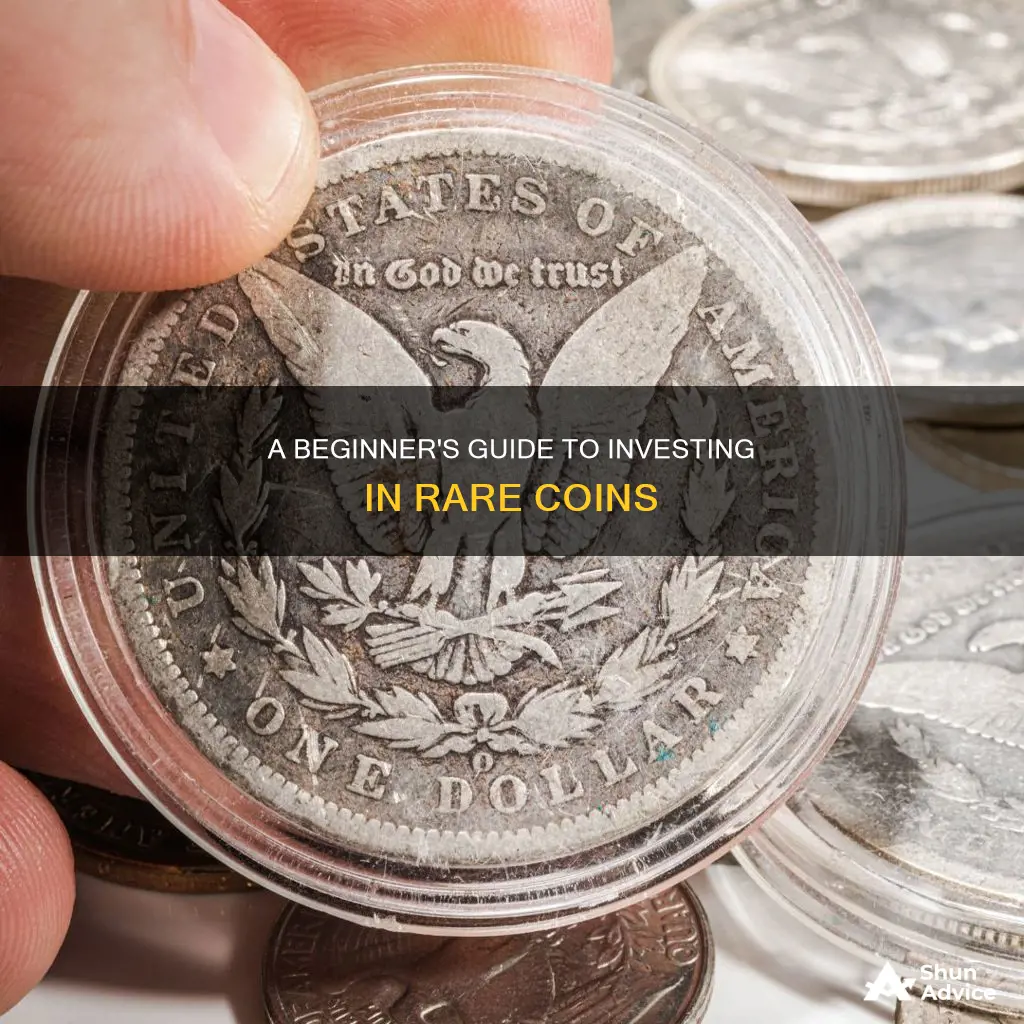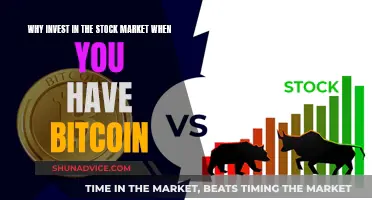
Investing in rare coins is a popular alternative to traditional stocks and funds, with investors attracted by the potential for high financial returns and the ability to own a piece of history. Rare coins are considered a commodity-like investment, with both sentimental and financial value. While investing in rare coins can be rewarding and profitable, it is not without risk. The market can be volatile, and investors need to be aware of the potential for fraud. To mitigate these risks, it is important to do your research, buy from reputable dealers, and seek advice from experts and collectors.
| Characteristics | Values |
|---|---|
| Diversification | Rare coins can be a great way to diversify your portfolio and reduce risk. |
| Collectibles | Rare coins are often considered a commodity-like investment, as there might be some sentimental value to them. |
| Hobby | Rare coin collecting is also known as the "Hobby of Kings". |
| Knowledge | It is important to do your research and become an expert in the field before investing in rare coins. |
| Expertise | Seek out a mentor who can guide you on your coin collecting journey. |
| Portfolio | Your portfolio of rare coins should include a variety of coins to minimize market fluctuations and maximize returns. |
| Quality | Buy high-quality certified coins. |
| Grading | The grade of a coin impacts its value. The two largest coin-grading services are the Professional Coin Grading Service (PCGS) and the Numismatic Guarantee Corporation (NGC). |
| Tax advantages | There are several tax advantages to holding rare coins, including possible exemptions from sales tax. |
| Profits | Rare coins can produce desirable ROI. |
| Bullion | Bullion coins have a higher "melt value" than numismatic coins. |
What You'll Learn
- Diversification: Rare coins can be a great way to diversify your portfolio and reduce risk
- Bullion vs Numismatics: Understand the difference between the two types of rare coin investing
- Tax Advantages: There are several tax benefits to holding rare coins, including possible exemptions from sales tax
- Profits: Rare coins can be profitable, but it's important to do your research and understand the market
- Grading: The grade of a coin impacts its value, so it's important to have it assessed by a credible expert

Diversification: Rare coins can be a great way to diversify your portfolio and reduce risk
Diversification is a key investment strategy to reduce risk. Rare coins can be a great way to diversify your portfolio and achieve this.
Firstly, rare coins are a tangible asset, and as such, they can be a good hedge against the volatility of the stock market and other paper investments. They are also a good way to protect against currency devaluation, inflation, and even economic collapse. Rare coins are a stable investment, and their performance is not as closely tied to the economy as stocks and bonds. This is not to say that rare coin prices do not fluctuate, and there are examples of the market losing value at an alarming rate, such as in 1989. However, the trajectory since 1995 has been upward, and the market has seen some record-breaking sales in recent years.
Secondly, rare coins can be a good diversification strategy because they have an intrinsic value that paper investments do not. Rare coins are made from precious metals like gold and silver, which have an inherent value. The value of a rare coin is determined by its quality, rarity, and historical significance. This is known as the extrinsic value of the coin.
Thirdly, rare coins are a good diversification strategy because they are a commodity-like investment. This means that they can have sentimental value, and collectors may feel like they are owning a piece of history. This is especially true for ancient coins dating back to the Roman Empire and ancient Greece.
Finally, rare coins are a good diversification strategy because they are not exclusive to the uber-wealthy. Novice collectors and investors on a limited budget can find good quality coins with growth potential in a variety of price ranges.
In conclusion, rare coins can be a great way to diversify your portfolio and reduce risk. They are a tangible asset with intrinsic value, and they are a commodity-like investment that is accessible to a wide range of investors.
Smart Move or Risky Bet: Investing $10K in Bitcoin
You may want to see also

Bullion vs Numismatics: Understand the difference between the two types of rare coin investing
When it comes to investing in rare coins, there are two main types: bullion and numismatic. Both have their own unique characteristics and appeal to different types of investors. Here, we will explore the key differences between these two types of rare coin investments to help you understand which option may be better suited for your needs.
Bullion Coins:
Bullion coins are primarily valued for their precious metal content. They are typically made of gold or silver and are bought for one of three main reasons: investment, inflation hedge, or survival. The weight of bullion coins is expressed as an even amount, such as 1 ounce or 1/2 ounce, and they are often manufactured year after year. Examples of bullion coins include Canadian Gold Maples, South African Krugerrands, and pre-1965 US silver coins. Bullion coins are usually available at a lower price point, making them more accessible to investors. Their value is tied to the spot price of the precious metal they contain, and they are widely circulated, making them easier to sell when needed.
Numismatic Coins:
On the other hand, numismatic coins are considered collectible and are valued for their rarity and historical significance rather than their metal content. These coins are generally older and made from various metals, which gives them a lower melt value. Numismatic coins are often sought after by collectors who appreciate their unique characteristics, such as special marks or minting methods. The value of a numismatic coin can be many times higher than the value of its precious metal content. For example, a rare gold coin could be worth 500 times the spot price of gold due to its numismatic value. However, investing in numismatic coins carries a larger risk as their value is subject to the laws of supply and demand and can be highly volatile.
Key Differences:
The main difference between bullion and numismatic coins lies in their intrinsic value. Bullion coins derive their value primarily from the precious metal they contain, while numismatic coins have external value due to their rarity, historical significance, or unique characteristics. Bullion coins are typically bought as an investment, inflation hedge, or for survival purposes, whereas numismatic coins are often purchased for personal collecting satisfaction. Numismatic coins tend to have a larger premium and carry more risk due to their reliance on collector demand.
Both bullion and numismatic coins offer unique investment opportunities in the rare coin market. Bullion coins provide a more stable and accessible option, backed by the value of their precious metal content. On the other hand, numismatic coins offer the potential for higher returns but carry more risk due to their dependence on collector demand and market factors. When deciding between the two, it is important to consider your investment goals, risk tolerance, and level of expertise in the rare coin market.
Worldcoin Investment: Worth Your Money?
You may want to see also

Tax Advantages: There are several tax benefits to holding rare coins, including possible exemptions from sales tax
Rare coins are considered "monetized bullion" and are therefore exempt from sales and use taxes in many states if purchased in amounts over $1,000 or $1,500 in a single invoice. This exemption allows rare coin investors to retain more of their investment while also having the option of doing business with local dealers.
Another tax advantage of investing in rare coins is that income from the sale of coins is tax-deferred until the coins are sold. This means that a coin investor can defer taxable gains until a time of their choosing. However, rare coins are considered capital assets for tax purposes once the taxpayer has held them for 6 months, which qualifies them for a reduced tax rate.
Additionally, rare coin investors can deduct expenses related to their coin portfolios, such as grading fees, insurance, security, membership dues for collectors' clubs, and subscriptions to relevant periodicals. To qualify as an investor for tax purposes, the taxpayer must show that they are buying coins primarily for profit rather than enjoyment. This can be demonstrated by showing a profit on coin trades for three of the past five years, relying on expert advice when making purchases, and being open to the possibility of losses in any given year.
Furthermore, rare coins can be part of a "like-kind" exchange under Section 1031 of the Internal Revenue Code. This provision allows investors to trade items that have appreciated in value for items of a similar nature without recognizing income or capital gains on the transaction. Rare coins have been deemed to qualify for this treatment by the IRS, allowing investors to defer income tax on any profits made through these exchanges.
Mark Cuban's Dogecoin Bet: Millions Invested
You may want to see also

Profits: Rare coins can be profitable, but it's important to do your research and understand the market
Rare coins can be a profitable investment, but it's important to understand the market and do your research before buying. Rare coin values are determined by several factors, including rarity, demand, and quality. The value of a rare coin can also be influenced by outside market factors such as inflation and the performance of other investment vehicles.
When investing in rare coins, it's crucial to have a good understanding of the market and the specific factors that drive coin values. The rarity of a coin is an important factor, as the rarer a coin is, the higher its value tends to be. Demand also plays a significant role, as a high demand for a particular coin can drive up its price. The quality of a rare coin is another key factor in determining its value, as a coin in better condition will typically be worth more than one that is worn or damaged.
In addition to these intrinsic factors, outside market forces can also impact the value of rare coins. For example, during times of economic uncertainty or high inflation, tangible assets like rare coins may become more attractive to investors, driving up their value. On the other hand, a downturn in the economy could cause rare coin prices to drop, as seen in the 1989 market crash.
To make profitable investments in rare coins, it's essential to have a strong knowledge base and do thorough research. This includes studying the rarity, denominations, values, and other aspects of different types of coins. It's also beneficial to consult expert resources, such as coin grading services like the Professional Coin Grading Service (PCGS) and the Numismatic Guarantee Corporation (NGC). These services grade and authenticate rare coins, providing valuable information for buyers and sellers.
Another important aspect of profitable rare coin investing is understanding the different forms of rare coins in the market. The market consists of two main types: numismatic rare coins, which are typically older and valued for their historical significance, and bullion rare coins, which have a high concentration of rare metals, usually gold. Numismatic coins are often seen as a niche investment strategy, while bullion coins are considered safer and more stable due to their tie to the price of gold.
By gaining a strong understanding of the market, researching specific coins, and consulting expert resources, investors can make more informed decisions when investing in rare coins. However, it's important to remember that rare coin investing carries risks, and there may be fluctuations in value over time.
A Beginner's Guide to Investing in Litecoin
You may want to see also

Grading: The grade of a coin impacts its value, so it's important to have it assessed by a credible expert
Grading is an essential step in determining the value of a rare coin. The grade reflects the coin's condition, which can vary significantly depending on factors such as wear, luster, strike quality, and the presence of any imperfections. The process involves expert graders examining each coin under magnification to assess these characteristics.
The grade of a coin is assigned a numerical value between 1 and 70, with higher grades indicating better condition and, consequently, higher value. This grading scale, known as the Sheldon Scale, provides a standardised way to describe a coin's condition, allowing collectors and dealers to communicate about coins using a common language.
While there are several coin grading services, the two most trusted and renowned companies are the Professional Coin Grading Service (PCGS) and the Numismatic Guaranty Corporation (NGC). These companies have graded millions of coins and are recognised for their expertise and rigorous evaluation processes. Their grades are highly regarded in the numismatic community and can significantly impact a coin's market value.
When investing in rare coins, it is crucial to have them graded by a credible expert, such as PCGS or NGC. Their unbiased opinion ensures that you, as a collector or investor, know the accurate condition and, by extension, the value of your coins. This information is vital when making informed decisions about buying, selling, or trading rare coins.
Additionally, grading services offer benefits beyond just determining the grade. They authenticate the coin, ensuring it is a genuine issue and not a counterfeit. They also encapsulate the coin in a protective holder to preserve its condition and provide a serial number for identification and security purposes. These services give collectors and investors peace of mind and help maintain the integrity of the rare coin market.
Binance Coin: Long-Term Investment Prospects and Predictions
You may want to see also
Frequently asked questions
The two main types of rare coin investments are numismatic coins and bullion coins. Numismatic coins are older and made from different types of metals, whereas bullion coins have a higher "melt value", i.e. the value of the metal they are made from if melted down.
The value of a rare coin is determined by its rarity, demand, and quality. The value of a coin can also be influenced by outside market factors such as inflation, the performance of other investment vehicles, and government policies.
While rare coin investments are generally considered more stable than other types of investments, they are not without risk. The rare coin market can be volatile, and even small distinctions between coins can make a big difference in their worth. Additionally, investing in rare coins requires a significant amount of knowledge and expertise, and it may take time to see a return on your investment.







